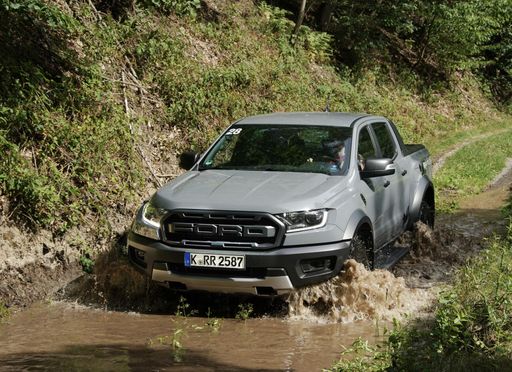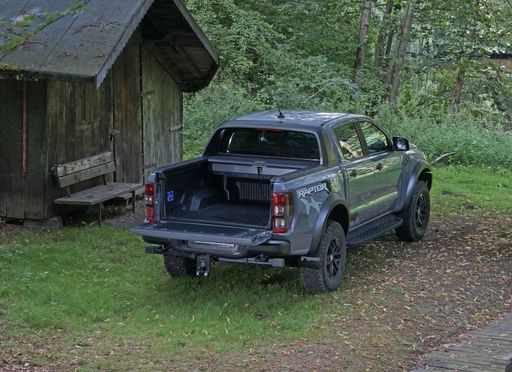Ford Ranger vs Renault Trafic Transporter – Differences & prices compared
Compare performance, boot space, consumption and price in one view.
Find out now: which car is the better choice for you – Ford Ranger or Renault Trafic Transporter?
The Ford Ranger (Pickup) comes with a Diesel, Petrol or Plugin Hybrid engine and Manuel or Automatic transmission. In comparison, the Renault Trafic Transporter (Cargo Van) features a Diesel or Electric engine with Manuel or Automatic transmission.
When it comes to boot capacity, the Ford Ranger offers , while the Renault Trafic Transporter provides – depending on how much space you need. If you’re looking for more power, decide whether the 292 HP of the Ford Ranger or the 170 HP of the Renault Trafic Transporter suits your needs better.
In terms of consumption, the values are 3.10 L per 100 km for the Ford Ranger, and 21.30 kWh6.70 L for the Renault Trafic Transporter.
Price-wise, the Ford Ranger starts at 34500 £, while the Renault Trafic Transporter is available from 33200 £. Compare all the details and find out which model fits your lifestyle best!
Ford Ranger
The Ford Ranger stands out in the pickup market with its robust build and versatile capabilities, making it a popular choice for both work and leisure. Its modern design is complemented by a well-equipped interior, providing comfort and advanced technology. Whether tackling challenging terrains or cruising through the city, the Ranger delivers a reliable and dynamic driving experience.
details @ media.ford.com
@ media.ford.com
 @ media.ford.com
@ media.ford.com
Renault Trafic Transporter
The Renault Trafic Transporter is a versatile vehicle known for its spacious interior and functional design, ideal for both business and personal use. Its stylish exterior combined with practical features offers a perfect balance between form and function, making it a popular choice among van enthusiasts. The driving experience is enhanced by its smooth handling and advanced technology, providing comfort and convenience for any journey.
details

|
|
|
|
|
Costs and Consumption |
|
|---|---|
|
Price
34500 - 68800 £
|
Price
33200 - 52500 £
|
|
Consumption L/100km
3.1 - 13.8 L
|
Consumption L/100km
6.7 - 7.8 L
|
|
Consumption kWh/100km
-
|
Consumption kWh/100km
21.3 - 21.5 kWh
|
|
Electric Range
50 km
|
Electric Range
289 - 292 km
|
|
Battery Capacity
11.80 kWh
|
Battery Capacity
-
|
|
co2
70 - 315 g/km
|
co2
0 - 206 g/km
|
|
Fuel tank capacity
80 L
|
Fuel tank capacity
80 L
|
Dimensions and Body |
|
|---|---|
|
Body Type
Pickup
|
Body Type
Cargo Van
|
|
Seats
2 - 5
|
Seats
3 - 6
|
|
Doors
2 - 4
|
Doors
4
|
|
Curb weight
2082 - 2486 kg
|
Curb weight
1885 - 2058 kg
|
|
Trunk capacity
-
|
Trunk capacity
-
|
|
Length
5370 - 5420 mm
|
Length
5080 - 5480 mm
|
|
Width
1918 - 1968 mm
|
Width
1956 mm
|
|
Height
1868 - 1922 mm
|
Height
1967 - 2509 mm
|
|
Payload
676 - 1108 kg
|
Payload
878 - 1185 kg
|
Engine and Performance |
|
|---|---|
|
Engine Type
Diesel, Petrol, Plugin Hybrid
|
Engine Type
Diesel, Electric
|
|
Transmission
Manuel, Automatic
|
Transmission
Manuel, Automatic
|
|
Transmission Detail
Manual Gearbox, Automatic Gearbox
|
Transmission Detail
Manual Gearbox
|
|
Drive Type
All-Wheel Drive
|
Drive Type
Front-Wheel Drive
|
|
Power HP
170 - 292 HP
|
Power HP
110 - 170 HP
|
|
Acceleration 0-100km/h
7.9 - 12.1 s
|
Acceleration 0-100km/h
10.8 - 15.1 s
|
|
Max Speed
180 - 190 km/h
|
Max Speed
110 - 178 km/h
|
|
Torque
405 - 697 Nm
|
Torque
245 - 380 Nm
|
|
Number of Cylinders
4 - 6
|
Number of Cylinders
4
|
|
Power kW
125 - 215 kW
|
Power kW
81 - 125 kW
|
|
Engine capacity
1996 - 2993 cm3
|
Engine capacity
1997 cm3
|
General |
|
|---|---|
|
Model Year
2022 - 2025
|
Model Year
2022 - 2023
|
|
CO2 Efficiency Class
G, B
|
CO2 Efficiency Class
G, A
|
|
Brand
Ford
|
Brand
Renault
|
Ford Ranger
A Comprehensive Look at the Ford Ranger: Versatility Meets Innovation
The Ford Ranger has long been a staple in the world of pick-up trucks, renowned for its robust design and versatility. Whether for rugged off-road adventures or everyday utility tasks, the Ford Ranger continues to be a frontrunner in the pick-up segment. In this article, we explore the technical details and innovative features that set the latest versions of the Ford Ranger apart from its competitors.
Powertrain Performance: A Range of Choices
The Ford Ranger offers a selection of powerful engines, catering to a diverse set of user requirements. Engine options range from the fuel-efficient 2.0-litre EcoBlue diesel engine to the robust 3.0-litre EcoBoost petrol engine, offering impressive outputs from 170 to 292 PS. These engines are paired with either a manual or an advanced automatic transmission, both providing smooth shifting and optimised performance across various driving conditions.
The Ranger’s all-wheel-drive system ensures a robust off-road capability while maintaining a composed ride on urban roads. With torque figures ranging between 405 Nm and 600 Nm, the Ranger guarantees ample pulling power whether you're on or off the beaten track.
Fuel Efficiency and Environmental Considerations
Recognising the importance of balancing performance with efficiency, the Ford Ranger delivers competitive fuel consumption figures ranging from 8.4 to 13.8 litres per 100 km. Despite its robust performance capabilities, the Ranger remains mindful of its environmental footprint, maintaining a functional balance between power and efficiency with a CO2 efficiency class of G.
Advanced Safety and Technology Features
Incorporating cutting-edge technology, the Ford Ranger is equipped with a suite of safety features designed to protect both passengers and payload. Among these are adaptive cruise control, lane-keeping assistance, and a pre-collision assist system, enhancing the driver's ability to navigate both rural roads and busy motorways safely and efficiently.
Moreover, the interior tech suite includes an intuitive infotainment system, complete with connectivity options for seamless integration of smartphones and smart devices. This ensures drivers and passengers can stay connected and entertained on all journeys.
Customisation and Comfort
The Ford Ranger offers a variety of trim levels, allowing customers to tailor the vehicle to their specific needs. From the rugged XL 4x4 to the luxurious Platinum e-4WD Automatik, there is a model to suit every preference and requirement. Equipment lines such as Wildtrak and MS-RT add enhanced styling and additional features for those seeking a more distinctive and upscale appearance.
Inside, the Ranger provides comfortable seating configurations for up to five passengers, with premium materials and ample storage space to ensure every journey is a pleasant experience. Users can also benefit from a range of comfort features, including climate control, premium audio systems, and adjustable seating.
Practicality Meets Payload
The Ford Ranger excels in practicality with its impressive payload capacity and spacious cargo bed, suitable for carrying everything from work equipment to recreational gear. With a maximum payload of up to 1,108 kg, the Ranger is more than capable of handling heavy loads, making it an ideal choice for both professional and personal use.
Additionally, the robust chassis and durable build quality provide long-lasting performance even under the most demanding conditions, ensuring reliability and endurance in the long term.
Conclusion: A Resilient Companion for All Terrains
With its capable engine choices, outstanding off-road capabilities, and a host of advanced features, the Ford Ranger continues to lead the way in the pick-up truck category. Whether for practical utility, adventurous pursuits, or simply as a reliable daily vehicle, the Ranger delivers on all fronts – a true testament to Ford’s commitment to innovation and quality in the automotive industry.
Renault Trafic Transporter
The Renault Trafic Transporter: A Modern Workhorse Unveiled
Renault has consistently set benchmarks in the world of commercial vehicles, and the Renault Trafic Transporter stands as a testament to its innovation and engineering prowess. With a robust design and a variety of configurations, this model addresses the diverse needs of modern businesses. Let’s delve into the technical details and innovative features that make the Renault Trafic Transporter a standout choice in its segment.
Power and Performance
The Renault Trafic Transporter is powered by a choice of 2.0-litre diesel engines boasting power outputs ranging from 110 to 170 PS (81 to 125 kW). The torque delivery is impressive, with figures ranging from 245 to 380 Nm, ensuring ample pulling power for heavy loads. For those seeking an environmentally friendlier option, Renault offers the Trafic with a 100% electric motor delivering 122 PS, a noteworthy addition to its line-up.
Efficient Fuel Consumption
When it comes to fuel efficiency, the diesel variants of the Renault Trafic maintain a commendable consumption range of 6.7 to 7.8 litres per 100 km. Meanwhile, the electric model showcases a consumption of 21.3 kWh per 100 km, with an electric range that stretches up to 292 km. This efficiency places it favourably within the CO2 efficiency classes from A to G.
Robust and Versatile Design
Versatility is at the heart of the Renault Trafic Transporter’s design ethos. With a wide range of body styles available, including options for an extended height or length, businesses can tailor the vehicle to meet their specific transport requirements. The vehicle offers configurations supporting 3 to 4 doors and a payload capacity that ranges from 867 to 1185 kg, ensuring adaptability to a broad spectrum of logistical challenges.
Advanced Features and Innovation
Inside, the Renault Trafic Transporter features a driver-focused cockpit, equipped with modern conveniences such as a multifunction steering wheel and an intuitive dashboard. The available Ecoline, Komfort, and Komfort EDC equipment lines offer varying levels of comfort and technology, ensuring a fit for every budget and preference.
Safety and Connectivity
Renault has prioritised safety in the Trafic Transporter, equipping it with advanced driver assistance systems and connectivity features to keep drivers connected and secure on the road. These innovations not only enhance the driving experience but also contribute to safer business operations.
Conclusion: A Smart Investment for Businesses
With its variety in configurations, impressive powertrains, and focus on efficiency, the Renault Trafic Transporter emerges as a leading choice for businesses nationwide. Whether navigating urban deliveries or long-distance hauls, this transporter provides the reliability and customization that modern enterprises demand, making it an investment well worth considering.
Which drive types are available for the Ford Ranger?
Available as All-Wheel Drive.
The prices and data displayed are estimates based on German list prices and may vary by country. This information is not legally binding.
